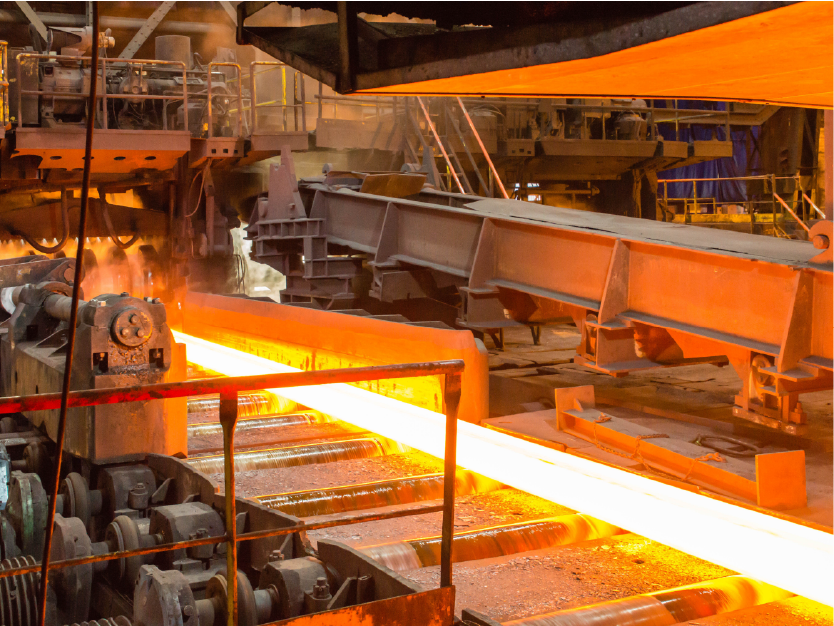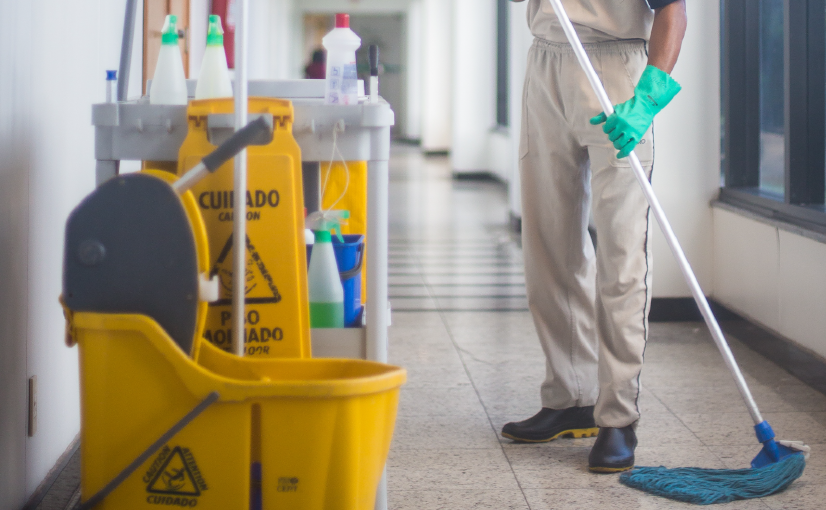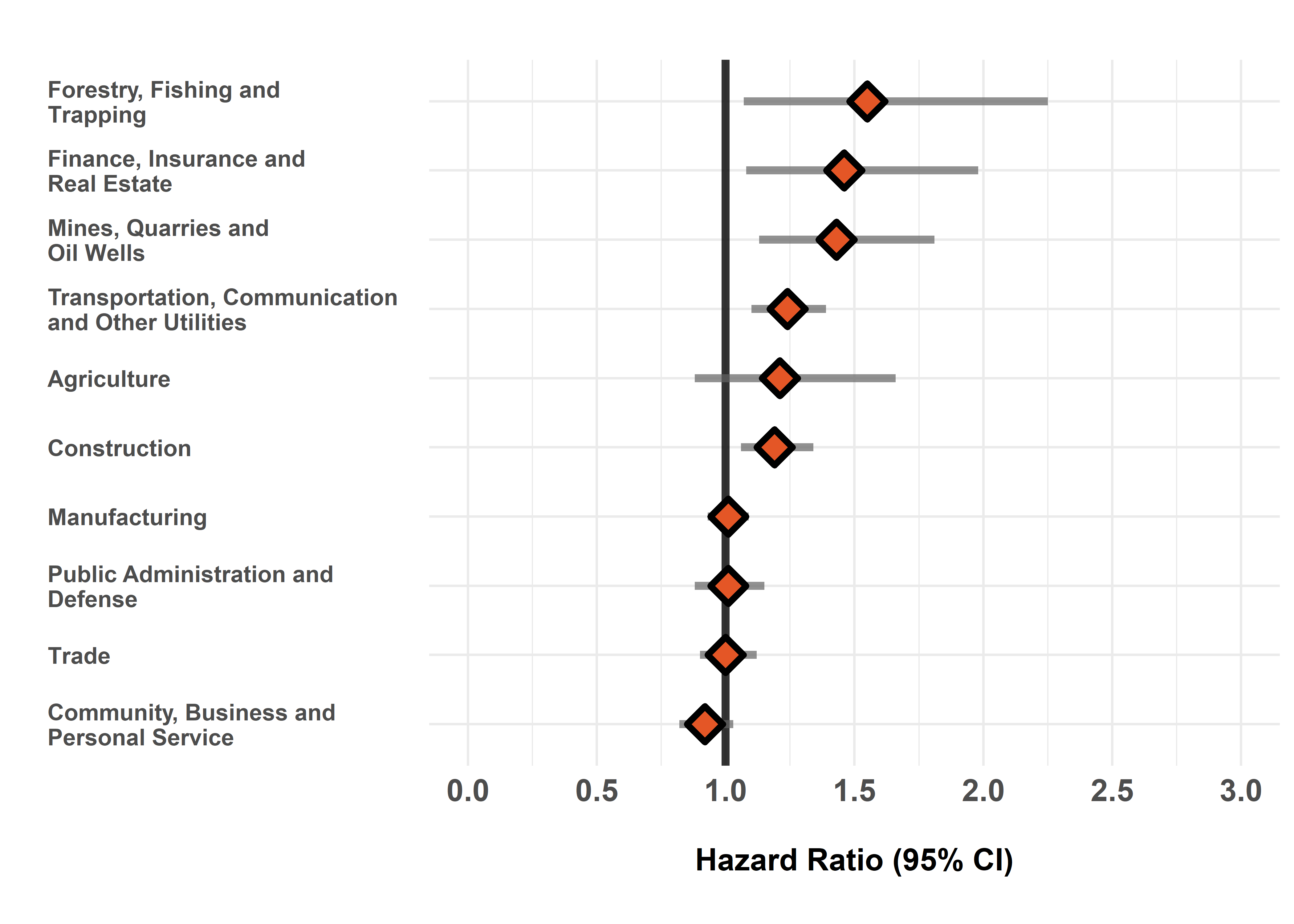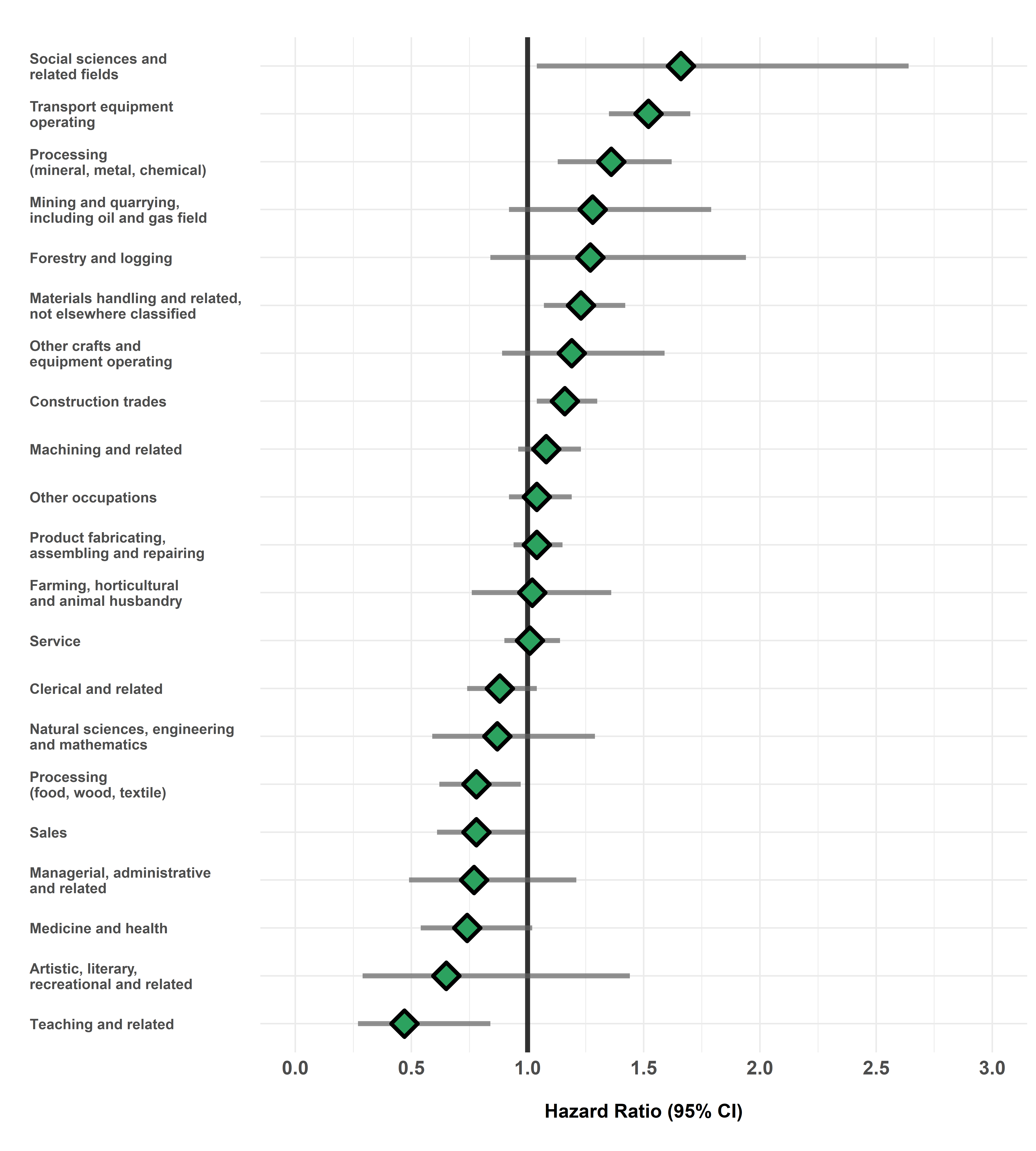Laryngeal Cancer
Background
Laryngeal cancer is a relatively rare cancer, and the Canadian Cancer Society estimates there will be 1150 new cases in 2020 [1]. It is more common in men than in women. Smoking and drinking alcohol are the most important non-occupational risk factors for laryngeal cancer.
Known occupational risk factors
-
- Asbestos [2]
- Strong inorganic acid mists (e.g. sulfuric acid) [2]
Possible occupational risk factors
-
- Second-hand smoking [2]
- Rubber production industry [2]
- Sulfur mustard (mustard gas) [2]
- Polycyclic aromatic hydrocarbons (PAHs) [3]
- Engine exhaust [3]
- Textile dust [3]
Key Findings
The greatest risks of laryngeal cancer were observed for construction trades occupations including among excavators, graders, and pavers, and glaziers. Construction trades workers may be exposed to asbestos, but non-occupational risk factors may also contribute to their risk of laryngeal cancer. Metal processing occupations and mining industries also had relatively high risks.
Construction
 Workers in the construction industry overall, as well as some specific trades, have an increased risk of laryngeal cancer. Construction workers may be exposed to many different known and suspected carcinogens including asbestos, which is a known risk factor for laryngeal cancer, and engine exhaust. Occupational differences in use of cigarettes and alcohol may contribute to the increased risk of laryngeal cancer among construction workers. Construction workers may also be exposed to second-hand smoke in the workplace, which is a possible risk factor for laryngeal cancer.
Workers in the construction industry overall, as well as some specific trades, have an increased risk of laryngeal cancer. Construction workers may be exposed to many different known and suspected carcinogens including asbestos, which is a known risk factor for laryngeal cancer, and engine exhaust. Occupational differences in use of cigarettes and alcohol may contribute to the increased risk of laryngeal cancer among construction workers. Construction workers may also be exposed to second-hand smoke in the workplace, which is a possible risk factor for laryngeal cancer.
-
- Excavating, grading, paving and related: 1.91 times the risk
- Other construction trades occupations: 1.21 times the risk
- Glaziers: 1.71 times the risk
- Roofing, waterproofing and related occupations: 1.65 times the risk
- Occupations in labouring and other elemental work, other construction trades: 1.42 times the risk
- Structural metal erectors: 1.36 times the risk
- Construction industry: 1.19 times the risk
Mining and metal processing
 An excess risk of laryngeal cancer was observed among mining industry workers, but work-related risk factors for this group are unclear. Some miners may have exposure to asbestos, but too few cases were observed among asbestos miners to explore the association specifically. Workers in the metal mining industry may be exposed to engine exhaust, which is a possible risk factor for laryngeal cancer. Smoking and alcohol may be important non-occupational risk factors for this group. Workers in primary metal industries may be exposed to acid mists [4].
An excess risk of laryngeal cancer was observed among mining industry workers, but work-related risk factors for this group are unclear. Some miners may have exposure to asbestos, but too few cases were observed among asbestos miners to explore the association specifically. Workers in the metal mining industry may be exposed to engine exhaust, which is a possible risk factor for laryngeal cancer. Smoking and alcohol may be important non-occupational risk factors for this group. Workers in primary metal industries may be exposed to acid mists [4].
-
- Metal processing and related occupations: 1.66 times the risk
- Mining and quarrying, including oil and gas field occupations: 1.28 times the risk
- Mines, quarries and oil wells: 1.43 times the risk
- Metal mines: 1.28 times the risk
- Primary metal industries: 1.26 times the risk
Other findings
 Janitors and cleaners are exposed to dust and various chemical solvents, and possibly asbestos, which may increase the risk of laryngeal cancer. Many vehicles have asbestos-containing materials that can result in exposure when they are repaired.
Janitors and cleaners are exposed to dust and various chemical solvents, and possibly asbestos, which may increase the risk of laryngeal cancer. Many vehicles have asbestos-containing materials that can result in exposure when they are repaired.
-
- Janitors and cleaners: 1.30 times the risk
- Industrial, farm and construction machinery mechanics and repairers: 1.26 times the risk
Relative Risk by Industry and Occupation
Figure 1. Risk of laryngeal cancer diagnosis among workers employed in each industry group relative to all others, Occupational Disease Surveillance System (ODSS), 1983-2016

The hazard ratio is an estimate of the average time to diagnosis among workers in each industry/occupation group divided by that in all others during the study period. Hazard ratios above 1.00 indicate a greater risk of disease in a given group compared to all others. Estimates are adjusted for birth year and sex. The width of the 95% Confidence Interval (CI) is based on the number of cases in each group (more cases narrows the interval).
Figure 2. Risk of laryngeal cancer diagnosis among workers employed in each occupation group relative to all others, Occupational Disease Surveillance System (ODSS), 1983-2016

The hazard ratio is an estimate of the average time to diagnosis among workers in each industry/occupation group divided by that in all others during the study period. Hazard ratios above 1.00 indicate a greater risk of disease in a given group compared to all others. Estimates are adjusted for birth year and sex. The width of the 95% Confidence Interval (CI) is based on the number of cases in each group (more cases narrows the interval).
Table of Results
Table 1. Surveillance of Laryngeal Cancer: Number of cases, workers employed, and hazard ratios in each industry (SIC)
| SIC Code * | Industry Group | Number of cases | Number of workers employed | Hazard Ratio (95% CI) † |
| 1 | Agriculture | 38 | 35,014 | 1.21 (0.88-1.66) |
| 2/3 | Forestry, Fishing and Trapping |
28 | 10,699 | 1.55 (1.07-2.25) |
| 4 | Mines, Quarries and Oil Wells |
71 | 23,200 | 1.43 (1.13-1.81) |
| 5 | Manufacturing | 949 | 693,585 | 1.01 (0.93-1.09) |
| 6 | Construction | 332 | 210,974 | 1.19 (1.06-1.34) |
| 7 | Transportation, Communication and Other Utilities |
313 | 197,212 | 1.24 (1.10-1.39) |
| 8 | Trade | 373 | 429,290 | 1.00 (0.90-1.12) |
| 9 | Finance, Insurance and Real Estate |
43 | 23,988 | 1.46 (1.08-1.98) |
| 10 | Community, Business and Personal Service |
368 | 599,658 | 0.92 (0.82-1.03) |
| 11 | Public Administration and Defense |
240 | 190,897 | 1.01 (0.88-1.15) |
| * SIC: Standard Industrial Classification (1970) | ||||
| † Hazard rate in each group relative to all others | ||||
Table 2. Surveillance of Laryngeal Cancer: Number of cases, workers employed, and hazard ratios in each occupation (CCDO) group
| CCDO Code * | Occupation Group | Number of cases | Number of workers employed | Hazard Ratio (95% CI) † |
| 11 | Managerial, administrative and related |
19 | 31,004 | 0.77 (0.49-1.21) |
| 21 | Natural sciences, engineering and mathematics |
26 | 26,349 | 0.87 (0.59-1.29) |
| 23 | Social sciences and related fields |
18 | 30,715 | 1.66 (1.04-2.64) |
| 25 | Religion | 0 | 128 | — |
| 27 | Teaching and related | 12 | 48,491 | 0.47 (0.27-0.84) |
| 31 | Medicine and health | 40 | 135,372 | 0.74 (0.54-1.02) |
| 33 | Artistic, literary, recreational and related |
6 | 14,996 | 0.65 (0.29-1.44) |
| 41 | Clerical and related | 137 | 197,348 | 0.88 (0.74-1.04) |
| 51 | Sales | 67 | 148,140 | 0.78 (0.61-0.99) |
| 61 | Service | 315 | 370,912 | 1.01 (0.90-1.14) |
| 71 | Farming, horticultural and animal husbandry |
47 | 50,150 | 1.02 (0.76-1.36) |
| 73 | Fishing, hunting, trapping and related |
<5 | 558 | — |
| 75 | Forestry and logging | 22 | 10,684 | 1.27 (0.84-1.94) |
| 77 | Mining and quarrying, including oil and gas field |
35 | 13,036 | 1.28 (0.92-1.79) |
| 81 | Processing (mineral, metal, chemical) |
126 | 79,239 | 1.36 (1.13-1.62) |
| 82 | Processing (food, wood, textile) |
80 | 99,250 | 0.78 (0.62-0.97) |
| 83 | Machining and related | 295 | 189,415 | 1.08 (0.96-1.23) |
| 85 | Product fabricating, assembling and repairing |
458 | 328,320 | 1.04 (0.94-1.15) |
| 87 | Construction trades | 377 | 215,593 | 1.16 (1.04-1.30) |
| 91 | Transport equipment operating |
343 | 168,109 | 1.52 (1.35-1.70) |
| 93 | Materials handling and related, not elsewhere classified |
205 | 153,057 | 1.23 (1.07-1.42) |
| 95 | Other crafts and equipment operating |
46 | 28,305 | 1.19 (0.89-1.59) |
| 99 | Other occupations not elsewhere classified | 255 | 215,261 | 1.04 (0.92-1.19) |
| * CCDO: Canadian Classification Dictionary of Occupations (1971) | ||||
| † Hazard rate in each group relative to all others | ||||
Please note that ODSS results shown here may differ from those previously published or presented. This may occur due to changes in case definitions, methodological approaches, and the ongoing nature of the surveillance cohort.
References
- Brenner DR, Weir HK, Demers AA, Ellison LF, Louzado C, Shaw A, Turner D, Woods RR, Smith LM. Projected estimates of cancer in Canada in 2020. Can Med Assoc J. 2020;192(9):E199–205.
- International Agency for Research on Cancer (IARC). List of Classifications by cancer sites with sufficient or limited evidence in humans, IARC Monographs Volumes 1-127 (2020).
- Paget-Bailly S, Cyr D, Luce D. Occupational exposures and cancer of the larynx—systematic review and meta-analysis. J Occup Environ Med. 2012;54(1):71–84.
- International Agency for Research on Cancer (IARC). Occupational exposures to mists and vapours from strong inorganic acids; and other industrial chemicals. IARC Monographs on the Evaluation of Carcinogenic Risks to Humans Vol. 54 (1992).
